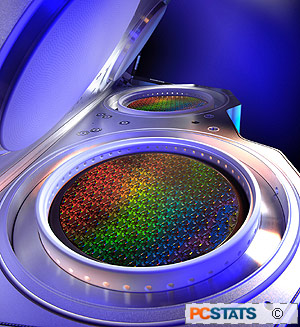Intel Pentium 4 3.2E GHz "Prescott" Processor Review
Remember back in
November of 2000 when the 1.5GHz Pentium 4 first came
to light? Massive memory bandwidth, a juiced clock frequency, and countless architectural improvements
promised a new era of performance. However, real-world tests on the fledgling
processor revealed that in many cases, the 1.2GHz AMD Athlon, and indeed 1GHz Intel Pentium III, were still
faster. Only later, as Intel improved the technology and augmented the chip's
speed, did it become an attractive platform.
Today,
the chip giant is in a similar bind. AMD has momentum following first a
successful launch of its AMD64 initiative, and then the subsequent unveiling of
its Athlon 64 3200+ and 3400+ processors. In order to
keep up, Intel has had to drop the price of the flagship 3.2GHz Pentium 4, which
is currently available for under $300USD ($512CDN).
Fortunately, Intel is in the position
to begin manufacturing processors using a 90nm process, the very latest wafer
technology that carries with it a host of other enhancements. Additionally, the
Pentium 4 itself has gone under the knife, reemerging with larger caches, new
instructions, and higher frequencies. The end result is a brand new core that,
in theory, should be significantly faster than its predecessor.
Intel is also taking the necessary steps to ensure that the
latest incarnation of its Pentium 4, formerly referred
to as 'Prescott', has the capacity to scale much higher than the
'Northwood' core before it. Unfortunately, the initial effect on performance is
significant enough to nullify the other architectural improvements.
 Representatives from Intel believe that the passing of time will see Prescott
assume the high-end position in its lineup, especially when software developers
start optimizing for the processor's many new features. One of Prescott's sexist attributes is the technology on which
it's manufactured. The new core represents Intel's first 90nm microprocessor, produced on
300mm wafers.
Representatives from Intel believe that the passing of time will see Prescott
assume the high-end position in its lineup, especially when software developers
start optimizing for the processor's many new features. One of Prescott's sexist attributes is the technology on which
it's manufactured. The new core represents Intel's first 90nm microprocessor, produced on
300mm wafers.
The
smaller process technology provides Intel higher yields per wafer, increasing
chip production and reducing costs. Whereas the Northwood core measures 146
square millimeters, Prescott is a petite 112. Consider that Northwood contains
55 million transistors to Prescott's 125 million, and you can see why
manufacturing processes play an integral role in determining the complexity of a
next-generation chip.
In the process of designing Prescott,
the core moved from six layers of copper interconnect to seven, giving Intel
more room to route electrical paths. Late in 2002, AMD used a similar tactic to
give its struggling Thoroughbred core extra headroom, a move that took the
Athlon XP from its 2200+ rating to 3200+.
Intel is also using strained
silicon technology, which is a technique whereby silicon atoms are spaced
further apart, resulting in less resistance as electrons flow through the
channels of transistors. According to Intel, strained silicon consequently
allows transistors to switch faster. Specifically, NMOS (negatively charged CMOS
transistors) devices enjoy a 10 percent improvement in drive current, while PMOS
(positively charged CMOS transistors) gain roughly 25 percent.
Keep in mind that Intel's
roadmap calls for a 65nm process by 2005, which will also utilize strained
silicon in addition to eight layers of copper interconnect using low-k
dielectric material.
Pass the Cache
The
massive jump in transistor count compared to Prescott's predecessor can be
primarily attributed to the new core's larger caches. The Execution Trace
Cache is still capable of storing 12k
micro-ops; however, the L1 data cache has doubled in size from 8KB to 16KB. It
is also 8-way set associative, as opposed to 4-way.
Prescott's L2 cache is two
times larger than the Northwood core before it, weighing in at 1MB. It's
attached to the processor core via a 256-bit bus, which, running at 3.2GHz,
yields 102.4GB per second of bandwidth. As Prescott continues scaling, that
number will follow suit. Incidentally, even while the Prescott is Intel's newest
core, the Extreme Edition family, currently based on the server-oriented
Gallatin core with 2MB of L3 cache, will persist as the top-end enthusiast
product.

